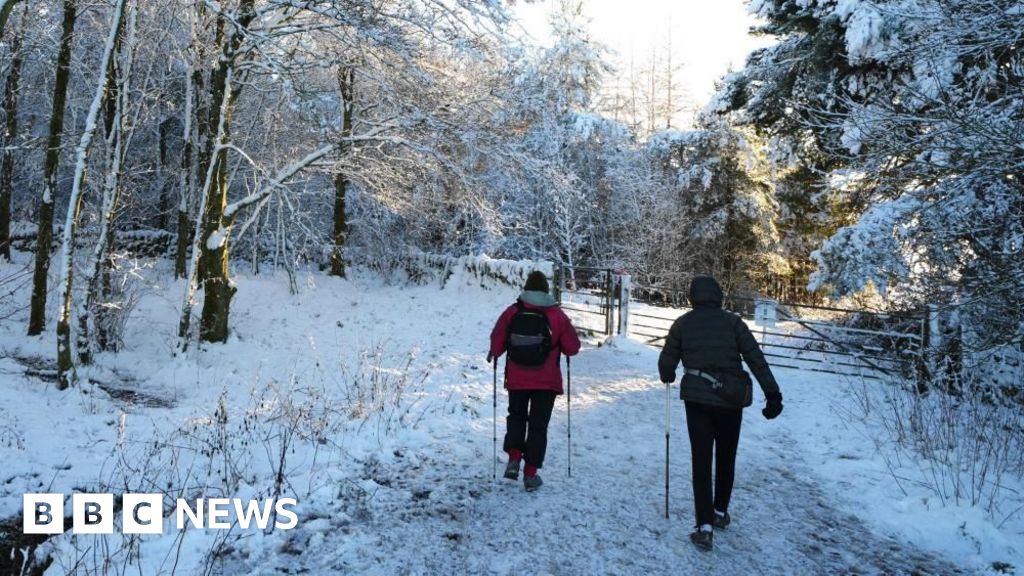Snow and ice warnings issued for parts of UK
Heavy snow and freezing rain are set to bring considerable disruption across the UK, with an amber weather warning now in force.
Parts of northern England, the Midlands and Wales are forecast to be among the worst hit as adverse weather pushes northwards throughout the night, possibly bringing 20-40cm (7.8-15.7in) of snow in some places.
The Met Office has warned of hazardous travel conditions and told motorists it is “safer not to drive”. Power cuts are possible and some rural communities could get cut off.
Less severe yellow weather warnings are also in force covering other areas, including Scotland, Northern Ireland and southern parts of England.
The amber weather warnings in place are:
- A warning for snow and freezing rain covering most of Wales and central England, including the Midlands and the north-west cities of Liverpool and Manchester, until noon on Sunday
- A separate warning for snow covering most of northern England including Leeds, Sheffield and the Lake District from 21:00 GMT on Saturday to midnight on Sunday.
Amber warnings are more serious than yellow warnings and indicate a possible risk to life due to severe weather, as well as more significant travel disruption.
Much of England and Wales is covered by a separate yellow warning for snow and freezing rain into Sunday, though there is uncertainty over how disruptive the adverse weather could be, with milder temperatures forecast.
Most of Northern Ireland, as well as an swathe of northern Scotland, are also covered by yellow warnings for snow and ice.
Prof Liz Bentley, chief executive of the Royal Meteorological Society, told BBC Radio 4’s Today programme that freezing rain occurs when droplets fall onto surfaces at temperatures below zero degrees and instantly freeze, causing a “glazed ice” on the ground.
Snowfall began in western parts of England on Saturday evening, and a zone of wet weather will continue to move northwards across England and Wales overnight, turning readily to snow as it interacts with the cold air that is sitting across the UK.
The heaviest snow is expected in higher parts of Wales, the Midlands and northern England with up to 30-40cm possible over the mountains of north Wales, the Peak District and the Pennines.
At lower levels some disruptive snow is likely but in places this will mix with rain – falling on cold surfaces, leading to the threat of ice.
Cumbria Police said on Saturday afternoon that it had received numerous calls about a multiple-vehicle collision on Wrynose Pass in the Lake District.
Road users in England’s north have been warned up to 25cm of snow could hit parts of the network including the A66 Old Spittal, A628 Woodhead Pass and M62 at Windy Hill.
Reuters
A stag lies amongst frosty foliage in Richmond Park on Saturday
Eastern parts of Northern Ireland could also see a little snow overnight with up to 10cm possible over the hills.
Snow and ice will also affect parts of southern and eastern Scotland through the early hours, with wintry showers in northern Scotland also giving the chance of slippery conditions.
Across southern counties of England and southern Wales any snow is likely to turn back to rain as milder air pushes in – temperatures in parts of south west England could be as high as 12C by the end of the night.
On Sunday further snow is expected to accumulate across parts of northern England, Northern Ireland and Scotland, where it will remain cold.
Heavy rain will be more of an issue across Wales, central and southern England where milder conditions will develop.
Fresh yellow weather warnings will also come into force in some areas on Sunday.
Heavy rain and thawing snow could lead to flooding in some parts of north-west England and Wales, while localised snow and ice warnings cover parts of Scotland where it will remain cold.
Temperatures are forecast to dip again from Monday, and UK Health Security Agency (UKHSA) amber cold weather health alerts for all of England remain in place.
